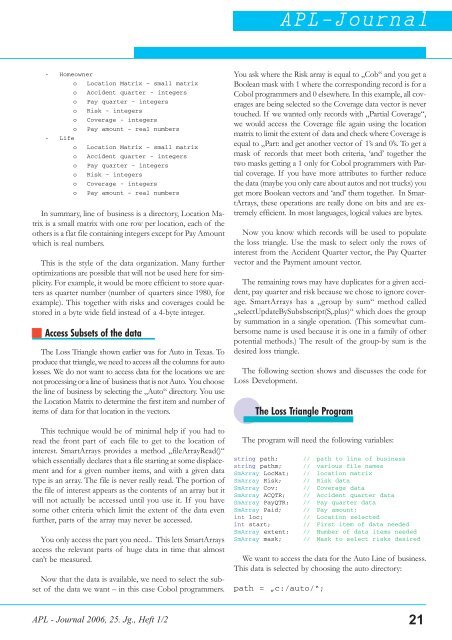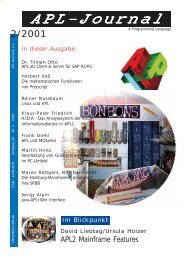APL-Journal - APL Germany e. V.
APL-Journal - APL Germany e. V.
APL-Journal - APL Germany e. V.
Create successful ePaper yourself
Turn your PDF publications into a flip-book with our unique Google optimized e-Paper software.
<strong>APL</strong>-<strong>Journal</strong><br />
- Homeowner<br />
o Location Matrix – small matrix<br />
o Accident quarter - integers<br />
o Pay quarter - integers<br />
o Risk - integers<br />
o Coverage - integers<br />
o Pay amount – real numbers<br />
- Life<br />
o Location Matrix – small matrix<br />
o Accident quarter - integers<br />
o Pay quarter - integers<br />
o Risk - integers<br />
o Coverage - integers<br />
o Pay amount – real numbers<br />
In summary, line of business is a directory, Location Matrix<br />
is a small matrix with one row per location, each of the<br />
others is a flat file containing integers except for Pay Amount<br />
which is real numbers.<br />
This is the style of the data organization. Many further<br />
optimizations are possible that will not be used here for simplicity.<br />
For example, it would be more efficient to store quarters<br />
as quarter number (number of quarters since 1980, for<br />
example). This together with risks and coverages could be<br />
stored in a byte wide field instead of a 4-byte integer.<br />
Access Subsets of the data<br />
The Loss Triangle shown earlier was for Auto in Texas. To<br />
produce that triangle, we need to access all the columns for auto<br />
losses. We do not want to access data for the locations we are<br />
not processing or a line of business that is not Auto. You choose<br />
the line of business by selecting the „Auto“ directory. You use<br />
the Location Matrix to determine the first item and number of<br />
items of data for that location in the vectors.<br />
This technique would be of minimal help if you had to<br />
read the front part of each file to get to the location of<br />
interest. SmartArrays provides a method „fileArrayRead()“<br />
which essentially declares that a file starting at some displacement<br />
and for a given number items, and with a given data<br />
type is an array. The file is never really read. The portion of<br />
the file of interest appears as the contents of an array but it<br />
will not actually be accessed until you use it. If you have<br />
some other criteria which limit the extent of the data even<br />
further, parts of the array may never be accessed.<br />
You only access the part you need.. This lets SmartArrays<br />
access the relevant parts of huge data in time that almost<br />
can’t be measured.<br />
Now that the data is available, we need to select the subset<br />
of the data we want – in this case Cobol programmers.<br />
You ask where the Risk array is equal to „Cob“ and you get a<br />
Boolean mask with 1 where the corresponding record is for a<br />
Cobol programmers and 0 elsewhere. In this example, all coverages<br />
are being selected so the Coverage data vector is never<br />
touched. If we wanted only records with „Partial Coverage“,<br />
we would access the Coverage file again using the location<br />
matrix to limit the extent of data and check where Coverage is<br />
equal to „Part: and get another vector of 1’s and 0’s. To get a<br />
mask of records that meet both criteria, ‘and’ together the<br />
two masks getting a 1 only for Cobol programmers with Partial<br />
coverage. If you have more attributes to further reduce<br />
the data (maybe you only care about autos and not trucks) you<br />
get more Boolean vectors and ‘and’ them together. In SmartArrays,<br />
these operations are really done on bits and are extremely<br />
efficient. In most languages, logical values are bytes.<br />
Now you know which records will be used to populate<br />
the loss triangle. Use the mask to select only the rows of<br />
interest from the Accident Quarter vector, the Pay Quarter<br />
vector and the Payment amount vector.<br />
The remaining rows may have duplicates for a given accident,<br />
pay quarter and risk because we chose to ignore coverage.<br />
SmartArrays has a „group by sum“ method called<br />
„selectUpdateBySubsbscript(S,.plus)“ which does the group<br />
by summation in a single operation. (This somewhat cumbersome<br />
name is used because it is one in a family of other<br />
potential methods.) The result of the group-by sum is the<br />
desired loss triangle.<br />
The following section shows and discusses the code for<br />
Loss Development.<br />
The Loss Triangle Program<br />
The program will need the following variables:<br />
string path; // path to line of business<br />
string pathm; // various file names<br />
SmArray LocMat; // location matrix<br />
SmArray Risk; // Risk data<br />
SmArray Cov; // Coverage data<br />
SmArray ACQTR; // Accident quarter data<br />
SmArray PayQTR; // Pay quarter data<br />
SmArray Paid; // Pay amount;<br />
int loc; // Location selected<br />
int start; // First item of data needed<br />
SmArray extent; // Number of data items needed<br />
SmArray mask; // Mask to select risks desired<br />
We want to access the data for the Auto Line of business.<br />
This data is selected by choosing the auto directory:<br />
path = „c:/auto/“;<br />
<strong>APL</strong> - <strong>Journal</strong> 2006, 25. Jg., Heft 1/2 21



